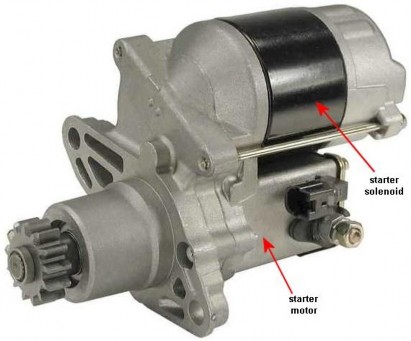
Figure 2.2 A starter with starter solenoid
Task 1 Match the underlined words from the text with the correct definitions
…………. …………. …………. …………. …………. …………. …………. …………... |
Có thể bạn quan tâm!
-
 Anh văn chuyên ngành Nghề Công nghệ ô tô - CĐ TC - Trường Cao đẳng nghề Đồng Tháp - 1
Anh văn chuyên ngành Nghề Công nghệ ô tô - CĐ TC - Trường Cao đẳng nghề Đồng Tháp - 1 -
 Anh văn chuyên ngành Nghề Công nghệ ô tô - CĐ TC - Trường Cao đẳng nghề Đồng Tháp - 2
Anh văn chuyên ngành Nghề Công nghệ ô tô - CĐ TC - Trường Cao đẳng nghề Đồng Tháp - 2 -
 The Liquid Gets Into The Radiator Through…………….. It Is Usually Mounted On The Top Of The Radiator.
The Liquid Gets Into The Radiator Through…………….. It Is Usually Mounted On The Top Of The Radiator. -
 Anh văn chuyên ngành Nghề Công nghệ ô tô - CĐ TC - Trường Cao đẳng nghề Đồng Tháp - 5
Anh văn chuyên ngành Nghề Công nghệ ô tô - CĐ TC - Trường Cao đẳng nghề Đồng Tháp - 5 -
 Anh văn chuyên ngành Nghề Công nghệ ô tô - CĐ TC - Trường Cao đẳng nghề Đồng Tháp - 6
Anh văn chuyên ngành Nghề Công nghệ ô tô - CĐ TC - Trường Cao đẳng nghề Đồng Tháp - 6
Xem toàn bộ 97 trang tài liệu này.
Task 2 Read the text and choose the best answers
1. The function of the starting system is ………………..
A-to provide fire to the engine B-to start the engine of the car C-to make the engine run
2. The …………..helps pass the current along.
A-starter solenoid B-a little device C- a car’s battery
3. Inside the battery, there is a set of plates, ………………
A-acid and distilled water B- electric current C- voltage
4. Some functions of the battery include ……………………
A-storing electricity for the starting system
B-providing electricity for the lights and the ignition system C-both A and B
5. After the starter solenoid receives the current from the battery, it sends the current to the starter to …………
A-make the car run
B-make the engine start to move
C-make the engine begin to operate
6. The starter is an electrical motor. It has …………. at one end
A-gear B-a starter drive C-both A and B
7. The ring gear on the flywheel is engaged to………...when the ignition switch is turned on
A-starter drive B-ring gear C-starter solenoid
8. The……………makes the crankshaft turn to cause the pistons to be able to go up and down.
A-spinning flywheel B-ring gear C-starter drive
Task 3 What do the underlined words in the following sentences refer to?
1. When you turn your key in the ignition switch to “Start,” the action closes a circuit that lets electric current flow from your car’s battery to itsstarter.
A-the car’s B-the ignition switch’s C-the circuit’s
2. Basically, all the solenoid does is passing the current along; you shouldn’t adjust or replace it unless itbreaks down.
A-the solenoid B-the current C-Both A & B
3. The battery stores electric current for starting the car, turning on the lights, and powering the ignition system. Italso stabilizes the voltage in the electrical system and provides current whenever the electrical demands exceed the output of the charging system.
A-the battery B-the car C-the ignition system
4. After the battery sends the current to the starter solenoid, the current goes to the starter. The starter is the device that makes your engine start to work. It’s an electrical motor with a gear called a starter drive at one end.
A-the battery B-the starter solenoid C-the starter
Task 4 Fill in each blank with a suitable word or phrases
fuel system | starting system | |
spins | engine | |
battery | cables | operate |
1. The starting system is designed to turn the engine until it can ………… under its own power. To do this, the starter motor is engaged to the engine’s………...
2. As the engine’s flywheel…………, it turns the engine’s crankshaft. The sole purpose of the ……………is to crank the engine fast enough to run.
3. The engine’s ignition and ……………provide the spark and fuel for engine operation, but they are not considered part of the starting system. They do affect how well an …………….starts.
4. The starter motor draws a great deal of current from the………….. A large starter motor might require 250 or more amperes of current. This current flows
through the large ………….that connect the battery to the starter and ground.
Task 5 Translate into Vietnamese
2. After the battery sends the current to the starter solenoid, the current goes to the starter. The starter is the device that makes your engine start to work. It’s an electrical motor with a gear called a starter drive at one end.
…………………………………………………………………………………………..……
……………………………………………………………………………………..…………
2. The starter drive engages a ring gear on a flywheel that’s bolted to the back of the engine crankshaft. When you turn your key in the ignition switch, the starter drive slides down the shaft and engages the ring gear.
…………………………………………………………..……………………………………
……………………………………………………..…………………………………………
3. This spins the flywheel, which starts the crankshaft turning so that the pistons can go up and down, the spark plugs can fire, and the engine can start running. As soon as the engine is started, the starter has done its job, and you should let go off the key.
…………………………..……………………………………………………………………
………………..………………………………………………………………………………
4. On the way, the current passes through a little device called the starter solenoid. Basically, all the solenoid does is passing the current along; you shouldn’t adjust or replace it unless it breaks down.
………………………………………………………………………………………..………
…………………………………………………………………………………..……………
Vocabulary
+run the engine (v) /rʌn Đə ˈendʒɪn/ chạy động cơ +ignition coil (n) /ɪɡˈnɪʃn kɔɪl/ cuộn đánh lửa, IC +starter (n) /ˈstɑːtə(r)/ máy khởi động +operate (v) /ˈɒpəreɪt/ vận hành, hoạt động +cable (n) /ˈkeɪbl/ cáp +stabilize the voltage (v) /ˈsteɪbəlaɪz Đə ˈvəʊltɪdʒ/ ổn định điện áp +provide (v) /prəˈvaɪd/ cung cấp +electrical demand (n) /ɪˈlektrɪkl dɪˈmɑːnd/ nhu cầu điện +exceed (v) /ɪkˈsiːd/ vượt +output (n) /ˈaʊtpʊt/ sản lượng +charging system (n) /tʃɑːdʒiŋ ˈsɪstəm/ hệ thống sạc +slide down (v) /slaɪd daun/ trượt xuống +spin (v) /spin/ xoay +voltage (n) /ˈvəʊltɪdʒ/ điện áp +break down (v) /breɪk daun/ hư, hỏng +distilled water (n) /dɪˈstɪld ˈwɔːtə(r)/ nước cất +plate (n) /pleɪt/: bản cực +store (v) /stɔː(r)/ trữ |
Giới thiệu:
UNIT 3 THE IGNITION SYSTEM
Mã bài: MH09-03
Trong bài này sinh viên được cung cấp một số thuật ngữ cơ bản liên quan đến các chi tiết của hệ thống đánh lửa trên xe ô tô. Sinh viên đọc hiểu bài khóa nói về các các chi tiết của hệ thống đánh lửa và thực hành các bài tập để rèn luyện kỹ năng đọc hiểu. Mục tiêu:
- Kiến thức:
+ Nhận biết các thuật ngữ cơ bản liên quan đến các chi tiết của hệ thống đánh lửa như bu-gi, bộ chia điện, hệ thống đánh lửa điện tử có bộ chia điện, hệ thống đánh lửa điện tử không có bộ chia điện, cảm biến trục khuỷu, cảm biến trục cam, tụ điện, cuộc đánh lửa, vít lửa...
+ Hiểu được nội dung chính của bài khóa tiếng Anh về các các chi tiết của hệ thống đánh lửa như bu-gi, bộ chia điện, cảm biến trục khuỷu, cảm biến trục cam, tụ điện, cuộc đánh lửa, vít lửa...
- Kỹ năng:
+ Đọc hiểu được nội dung bài khóa tiếng Anh liên quan các chi tiết của hệ thống đánh lửa trên xe ô tô như trên.
- Năng lực tự chủ và trách nhiệm:
+ Phát triển khả năng làm việc độc lập và làm việc theo cặp/nhóm.
+ Tự đánh giá kết quả của bản thân hoặc của các thành viên trong cặp/nhóm sau khi hoàn thành bài tập.
THE IGNITION SYSTEM
The function of the ignition system is to ignite the spark plugs in order to generate power to run the engine. To do so, the battery sends current to the ignition coil. Then that high voltage goes on to the spark plugs either through a distributor, if you have an older vehicle, or directly to the spark plugs, if you have a newer one.
Most vehicles built prior to 1974 use a non-electronic distributor ignition system. Most vehicles built from the mid-1970s to late 1980s use an electronic distributor ignition system. Today, most vehicles use a distributorless electronic ignition system.
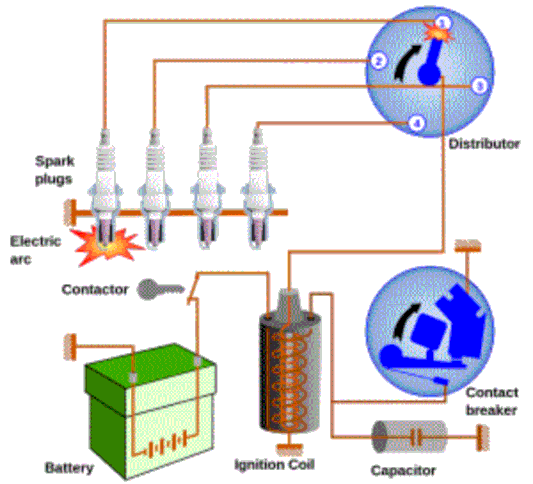
Figure 3.1 A distributor ignition system
The ignition coil
The ignition coiltransforms the relatively small amount of electrical voltage that it receives from the battery into a big enough amount of voltage to jump the spark plug gap. On most cars, a set of spark plug wires carries the high voltage to each spark plug. A distributorless system has an electronic coil module that does the same thing.
The spark plugs
The spark plugs deliver the sparkof voltage to the combustion chamberjust when the fuel/air mixture is at the point of greatest compression. The resulting explosion provides the power to propel your vehicle.
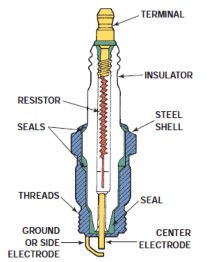
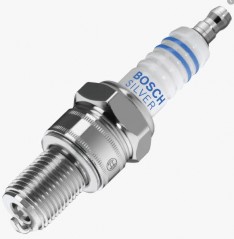
Figure 3.3 A Typical spark plug |
The distributor
The distributor gets the voltage from the coil and distributes it to each spark plug in turn. It also contains the rotor and, on older cars, a set of breaker points, and a condenser.
The distributor cap
The distributor cap sits atop the distributor to protect the parts inside from the elements. Current enters and leaves the distributor via the coil and spark plug wires that run through holes in the cap.
Rotor
The rotor sits atop the distributor shaftinside the distributor. As the distributor shaft turns, the rotor rotates with it and points toward the terminal at the base of each spark plug wire so that each plug can fire in the correct order.
Points
On these distributors, the points trigger the flow of electricity so that it arrives at the spark plugs at just the right point in time and at the right intensity. The points are two pieces of metal, one stationary and one moveable. The points are joined at one end so that they can touch and then draw apart.
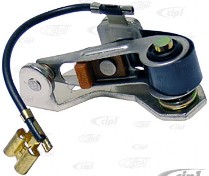
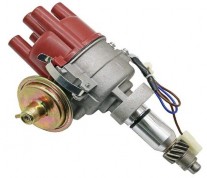
Figure 3.4 A set of breaker point
The tiny space created between the open points is called a gap. Each time the points open, electric current passes to the rotor, which directs the current to a particular spark plug wire. This causes that spark plug to “fire,” producing a spark that ignites the fuel/air mixture in its cylinder. The points are then brought back to the closed position by a spring.
The condenser
The condenser is an electrical “sponge” that keeps the points from burning up. This small metal cylinder prevents the electricity from arcing across the gap when the points are open, which would cause the points to burn. Condensers should be replaced periodically, along with the points and rotor.
Other parts found only on electronic distributors
Electronic distributors use electronic parts. They include the following parts:
+ An ignition module is a transistorized component that triggers the ignition coil to fire high voltage.
+A triggering mechanism inside the distributor or on crankshaft controls the timing of the ignition module. On some vehicles, this is a magnetic pulse generator called pick-up coil. Other vehicles use a photoelectric sensor inside the distributor to trigger the module.
Other parts found only on distributorless ignition systems
Distributorless ignition systems use a solid-state ignition module, along with the following additional parts:
+ A crankshaft sensor is a trigger device that tells the ignition module when to fire the park plugs.
+ A camshaft sensor, found on some distributorless ignition systems, is a trigger device that synchronizes when proper ignition coil should be fired.
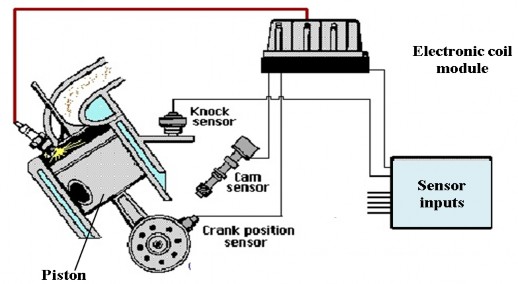
Figure 3.6 A typical distributorless ignition system
Task 1 Match the underlined words from the text with the correct definitions
…………………. …………………. …………………. …………………. …………………. …………………. …………………. …………………. …………………. |
1. a metal bar that joins parts of a machine or an engine
Task 2 Read the text and choose the best answers
1. The ignition system is designed to ignite the spark plugs in order to generate power to run the engine. Today, most vehicles do not use ………………….. A- a non-electronic distributor ignition system
B-a distributorless electronic ignition system C-electronic ignition system
2. The spark plugs send the spark of voltage to the combustion chamber when……………………
A-an explosion happens to produce the power to propel your vehicle
B-the compression of the mixture of air and fuel reaches its highest point C-the car has enough fuel to work
3. The function of the distributor is …………… A-getting the voltage from the coil
B-distributing the voltage to each spark plug in turn. C-both A and B
4. The rotor rotates with distributor shaft and points toward the terminal at the base of each spark plug wire ………………
A-to provide enough fire
B-ignite in the correct order
C-to make sure that it provides enough fire
5. The function of the points is to …………….
A-trigger the flow of electricity to arrive at the spark plugs at just the right point in time
B-trigger the flow of electricity to arrive at the spark plugs at the right intensity
C-both A and B
6. The points consist of two pieces of metal ………………………





